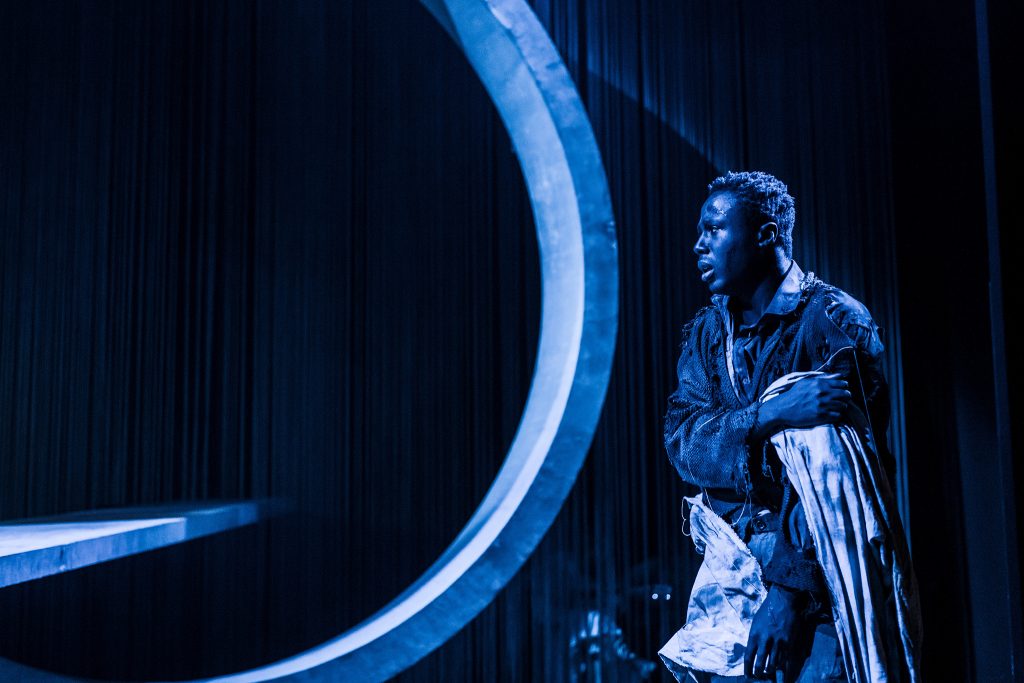In this production of The Wheel by Zinnie Harris, the audience is exposed to war in many forms. Sometimes, it feels like World War I, sometimes more contemporary wars are alluded to in this patchwork display of conflicts. The overall effect displaces the action from any one specific known war, making the story feel more universal and reflecting a more general sense of disaster.

Courtesy of Mihaela Bodlovic.
As the play begins, the audience is introduced to Rosa, played by Bella Maclean, and Beatriz, played by Anya Murphy, who are discussing Rosa’s upcoming wedding to Tomas, played by Mackenzie Heynes. Their wedding, however, never happens as soldiers arrive, declaring a war has broken out.
Beatriz is separated from her sister, and is swept away into the no man’s land created by the war. On her way, she finds herself caring for a number of children, including a silent girl, played by Phia Saban and a young man, played by Shaka Kalokoh. Together, they wander through war zone after war zone, trying to find the girl’s father.
Ana Inés Jabares-Pita’s design is engaging and heightens the play’s displacement of a particular time or space. Sand is strewn across the stage, completely covering it, which suggests more of a desert war than the trenches of either the first or second World Wars. In addition to this, a literal wheel of more than 6 feet in diameter has been placed upstage with a long platform extended out of it downstage.
This wheel serves as an entrance for many characters who seemingly appear out of nowhere and walk through the wheel. This has an effect of creating a sense of lost time as the wheel hints at a timeless portal out of which characters from different eras and different conflicts appear to interact with the main characters. Jabares-Pita’s design is effectively used to highlight the universality of a warzone, which may differ in timelines or politics, but are ultimately all the same for the people experiencing it.
Caroline Bryne’s directing uses a popular device in recent years which is to film the performance and project the live images as the action unfolds on stage. This is a tricky device as it can distract the audience’s attention from the performance itself. While at times the use of the camera does teeter on the edge of being a distraction, overall the device is useful as it adds to the story in interesting ways and contributes to the atmosphere of the warzone.
Bryne has also focused much of her direction on the action between the main characters. While the main cast (Beatriz, A Boy and A Girl) relate well on to another, the ensemble cast seem to fade slightly into a blur of characters that are not particularly well defined.
In the main cast, Saban stands out particularly in her silent portrayal of a disturbed young girl, which is both frightening and intriguing. This is even more impressive as she is constantly surrounded by characters who are very animated. Yet, her quiet control evokes an eerie presence that is unsettling in the best possible way.
In the ensemble cast Brandon Bassir stands out particularly in his portrayal of the blood-hungry Glennister who provides the only true moment of comic relief in this piece. His performance is both disturbing and comical as he plays with the corpse of a dead bird, a scene that feels almost stolen from a Tarantino movie and Bassir delivers it with seamless swagger. Finally, Chirag Benedict Lobo playing the naturalist Rossignol is commendable in his truthful portrayal of a character torn by the desire to save himself and the need to act with integrity. Lobo’s performance stands out because of his ability to act with an honesty that makes it easy for the audience to empathise with him.
The play ends where it began creating a loop that suggests the never ending nature of war that continuously reappears after periods of peace. While the design is commendable and the acting has its highlights, the overall effect of this show is lost in the blur of faces and places that the main cast wander through the duration of the show. This makes their experience difficult to relate to, but perhaps this is the nature of war itself, continuously propelling its victims and pawns further down paths that displace them, without home or family until they create a new one only to see it destroyed in turn. The show therefore can be seen as truthful in its abilty to self reflectively blur its pawns into one. 4/5
Review written by Liz Leemann.
The Wheel was shown from Monday 21st until Saturday 26th October 2019 at Milton Court Theatre (Barbican Centre). To find out more about the production, visit here…


Leave a Comment